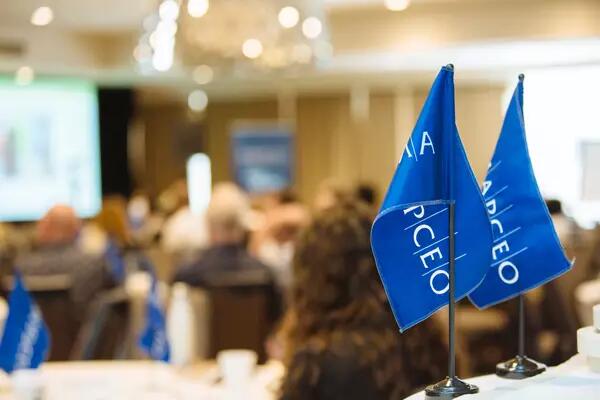AMAPCEO operates from the grassroots up.
AMAPCEO members each belong to one of eleven geographic Districts, according to their workplace location. Members participate in the union's governance by electing their District's Director and the Delegates they wish to represent them at the Annual Delegates' Conference (ADC). At the ADC, Delegates consider resolutions and constitutional amendments. They are also responsible for electing the union's Executive (President, Vice-President, Secretary, Treasurer) every year.
The President (who serves as the Chief Executive Officer of the union) and the Vice-President work full-time in the AMAPCEO office on leave from their positions in the bargaining unit. Elections for these two positions are staggered year-to-year to ensure strong representation for our membership.
Our structure

Annual Delegates' Conference (ADC)
The Annual Delegates’ Conference, AMAPCEO’s highest governing body, consists of the 15 members of the Board of Directors, elected District Delegates, and any elected Bargaining Unit Delegates.
The ADC is responsible for electing the Executive Officers, approving the annual budget, setting the level of membership dues, accepting audited financial statements, adopting constitutional amendments, and voting on bargaining priorities. The Conference typically meets once each year in late fall, though multiple meetings are possible in a year.
The number of Delegates is determined by the number of signed members within each District according to the following formula:
- 15 Delegates for the first 750 signed members
- one Delegate for every 75 signed members for the next 750 members (751–1,500)
- one Delegate for every 100 signed members thereafter (1,501+).
Any bargaining unit not otherwise represented by a District Delegate is also entitled to a Bargaining Unit Delegate.
Annual Delegates' Conference & Delegate information (sign-in required) »
Audit Committee
The Audit Committee is intended to provide an arm’s length, independent review of AMAPCEO’s financial statements, to monitor financial policies and to recommend the appointment of, and liaise with, our external auditing firm. The external auditors conduct the annual audit and prepare the audited financial statements for presentation to the Delegates.
The Committee consists of five members elected by the Delegates and members serve two-year terms, staggered so that three members are elected one year and two members are elected in the alternate year. Any signed member (in good standing) is eligible to sit on this Committee, except:
- current members of the Board of Directors, and
- Any member in good standing may seek election, except for any member who has been a Board Director within the last 24 months.
The Committee elects a Chair and a Vice-Chair. The AMAPCEO Treasurer attends meetings of the Audit Committee in a non-voting resource capacity. The Audit Committee is entitled to meet alone with the external auditors (without the Treasurer or AMAPCEO staff) once each year. The Committee typically holds three or four meetings a year, both in person and by teleconference. More information on the role and responsibilities of the Audit Committee can be found in By-law #3.
Constitutional Review Committee
The Constitutional Review Committee is an ADC committee struck every five years to conduct a formal review of the Constitution, By-laws, and District/Community boundaries.
The next review is expected to be scheduled in 2021, at which time nominations will be sought for this Committee. In the past, the Committee has consisted of five Delegates, although this is subject to change each time the Committee is struck.
Elections & Credentials Committee
The Elections and Credentials Committee (ECC) is intended to operate as an independent, arm’s length, non-partisan body to manage AMAPCEO’s nomination and election process.
The Committee consists of five members whose terms are staggered, with three members elected one year and two members elected in the alternate year. Members’ terms begin on January 1 following their election. Any signed member (in good standing) is eligible to sit on this Committee. The Committee elects a Chair and a Vice-Chair, and the Chair serves as the Chief Returning Officer for all elections that fall under the jurisdiction of the ECC.
ECC members are prohibited from being nominated as a member of the Board of Directors during their term of office and members of the Board may not be nominated for, or serve on the ECC, while a member of the Board. If they are not already Delegates, ECC members will be appointed as Delegates-at-Large to enable them to attend the ADC.
The Committee holds at least two meetings a year in person with additional meetings held by teleconference as required.
Resolutions Committee
The Resolutions Committee is responsible for inviting, reviewing and recommending action on policy resolutions submitted by Delegates and committees for consideration at the Annual Delegates’ Conference (ADC). Most of the work of the Committee occurs in the fall of each year and at the ADC, requiring one in-person meeting and possibly one or two teleconference meetings.
The Committee consists of five members elected by the Delegates and members serve two-year terms, staggered so that three members are elected one year and two members are elected in the alternate year. Any seated Delegate is eligible to sit on this Committee. The Committee elects a Chair and a Vice-Chair. There are two voting ex-officio members who sit on the committee: the Secretary of AMAPCEO and another Board member selected by the Board.
Board of Directors
The Board of Directors consists of:
- eleven District Directors, each directly elected and representing one of AMAPCEO's geographic districts; and
- four Executive Officers: the President, Vice-President, Secretary, and Treasurer, each elected at the ADC.
The Board is responsible for preparing policies for consideration by the ADC, implementing the decisions of governance bodies, spending funds in accordance with the annual budget, interpreting the AMAPCEO Constitution, and managing the bargaining process for the OPS unit and, generally, for exercising authority not specifically assigned to the Delegates, to whom the Board is accountable for its actions.
Districts
AMAPCEO members each belong to one of eleven geographic Districts, according to their workplace location. Each District's Director has a seat on the AMAPCEO Board of Directors, and chairs their local District Executive, which is comprised of the elected Delegates from their District.
Larger geographic Districts are subdivided into Communities, to address the distance between members and to ensure more equitable representation by Delegates.
A map of AMAPCEO members' work locations is below, divided by District.
Constitution, By-laws, Policies & Procedures
The AMAPCEO Constitution and By-laws describe the union’s governance structure, including the authority and responsibilities of governing bodies and elected officials to act on behalf of the organization in representing members.
In addition, the Board of Directors has adopted a set of policies and procedures which provide the necessary framework of values and rules for appropriate Board governance.
Elections
Principles and general rules for elections are outlined in AMAPCEO's Constitution, while detailed rules are codified in our Elections By-law.
Nominations and elections at AMAPCEO are overseen by the Elections & Credentials Committee, an independent, arm's length, non-partisan body.


